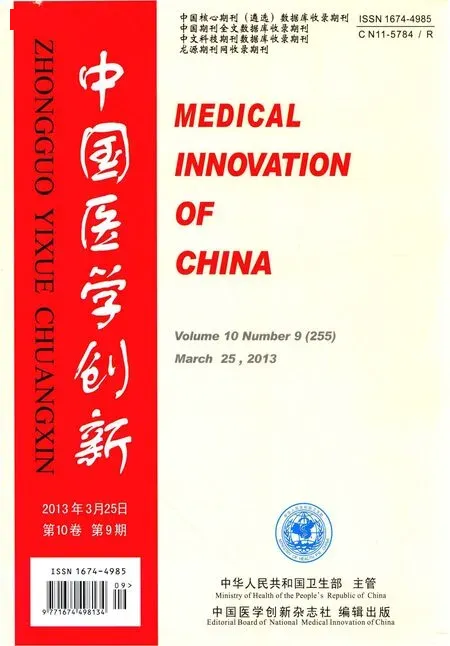糖尿病和甲状腺癌的关联
康璇 曹仁贤
基于糖尿病患者有较高的发生各类肿瘤的风险,甲状腺癌为甲状腺最常见的恶性肿瘤,几项关于糖尿病和甲状腺癌之间关联的流行病学表明女性糖尿病患者中甲状腺癌的风险不同程度升高。目前对于糖尿病与甲状腺癌关联的结论存在争议,以下将回顾文献报告中糖尿病和甲状腺癌之间可能的关联,为进一步的研究提供方向。
1 流行病学研究
研究表明,糖尿病与各种癌症,如乳腺癌、膀胱癌、前列腺癌、非霍奇金淋巴瘤的风险增加有相关性[1-4]。统计分析显示,糖尿病、肥胖和代谢综合征为癌症发展的潜在风险因素[5-6]。糖尿病患者中甲状腺疾病的患病率(10.8%)高于普通人群(6.6%)[7]。目前尚不清楚糖尿病对甲状腺癌发生的作用。几项关于糖尿病和甲状腺癌之间的关联的公开研究[8-11],观察到女性糖尿病患者中甲状腺癌的风险不同程度升高,男性糖尿病患者中甲状腺癌的风险没有变化或者没有显著的升高[8-10]。对于糖尿病与甲状腺癌的关联的结论存在争议。本文将回顾文献报告中糖尿病和甲状腺癌之间的关联和这种关联可能的机制。
2 糖尿病与甲状腺癌相关的危险因素
目前,存在一些糖尿病与甲状腺癌相关的危险因素,包括体重指数(BMI),胰岛素水平升高,高水平的促甲状腺激素(TSH),长期的高血糖和高甘油三酯,维生素D缺乏症,使用降糖药包括胰岛素和磺脲类药物[11]。已有流行病学研究表明甲状腺癌和BMI、促甲状腺激素、血糖和甘油三酯之间存在联系。
2.1 甲状腺癌的分子发病机制 甲状腺通过滤泡细胞的旁分泌功能分泌诸如胰岛素样生长因子I(IGF-1)和成纤维细胞生长因子对细胞的生长进行密切的调控[12]。甲状腺存在三个不同的有丝分裂途径:激素受体腺苷酸环化酶cAMP的蛋白激酶A系统(AC/cAMP/PKA),激素受体酪氨酸蛋白激酶(RTK)途径,激素受体磷脂酶C级联(PLC)途径[13]。TSH通过结合促甲状腺激素受体(TSHR)成为AC/cAMP/PKA信号通路的主要刺激物,这条途径调节甲状腺的功能、分化和增殖[14]。表皮生长因子(EGF)刺激RTK通路,导致转录活性的增加[15]。促甲状腺激素、神经递质、生长因子和佛波醇酯激活PLC途径,增加细胞内钙离子和蛋白激酶C活性[16]。有丝分裂途径的影响因素可能参与了甲状腺癌的发病机制,其分子发病机制与遗传有关,在滤泡状甲状腺癌中频繁地发现RAS基因点突变的激活,在甲状腺乳头状癌发现跨膜受体基因(RET,TKR)的重排与BRAF基因酪氨酸激酶活性和活化点突变,低分化和未分化甲状腺癌发现P53基因点突变的失活,RET原癌基因的突变可能与甲状腺髓样癌的发生有关[17]。
2.2 胰岛素水平升高和甲状腺癌的风险 糖尿病患者血循环中胰岛素水平慢性升高,可能是由于胰岛素抵抗或药物治疗。胰岛素与IGF-1受体有同源性和亲和性,对细胞增殖和凋亡起到重要作用[18]。多种癌症与高胰岛素和IGF-1水平有关,例如乳腺癌和结肠癌[19-20]。培养滤泡细胞,用促甲状腺激素和胰岛素共同处理组比仅用促甲状腺激素处理组使得细胞数量显著增加[21],这表明,胰岛素可以模拟IGF-1在滤泡细胞中的作用。滤泡细胞合成IGF-1且有IGF-1的受体,它通过增强TSH的作用来参与甲状腺结节的发病机制[22]。因此,胰岛素参与甲状腺癌的发生。一些研究证明胰岛素抵抗与甲状腺结节和甲状腺癌之间的关联[23]。然而,暂时未有以人为对象的研究直接证实胰岛素和甲状腺癌之间的关联。
2.3 TSH和甲状腺癌的风险 正如上文所述,TSH参与甲状腺的有丝分裂途径[13]。TSH是甲状腺癌发展的一个独立的危险因素,甲状腺癌的风险增加与较高的TSH水平有关[24]。糖尿病患者更易出现慢性轻度TSH升高。研究表明,3%的胰岛素依赖糖尿病患者有甲状腺功能减退症,13%~20%有TSH水平升高和抗甲状腺抗体[25]。2型糖尿病患者原发性甲状腺功能减退的比率高于非糖尿病人群(比值比=3.45,95%CI:2.51~4.79)[26]。甲状腺癌风险的增加可能与糖尿病患者的TSH水平升高有关。
2.4 BMI的增加和甲状腺癌的风险 肥胖与多种类型的癌症相关,如食管、结肠、肾、子宫内膜腺癌和恶性黑色素瘤[27]。肥胖者有较高的罹患糖尿病的风险,并可能增加甲状腺癌的风险[11,28-29]。Meta分析结果显示BMI增加5 kg/m2,甲状腺癌的危险性增加,男性(RR=1.33,P=0.02),女性(RR=1.14,P=0.001)[29]。肥胖和甲状腺癌风险相关的潜在机制包括TSH水平升高、胰岛素抵抗等。有研究表明BMI与TSH水平呈正相关[28]。正如上文所述,TSH和胰岛素影响滤泡细胞的生长和分化[29]。BMI的增加和甲状腺癌可能相关。
2.5 降糖药和甲状腺癌的风险 根据以往的研究,磺脲类药物与死亡率增加有关(HR=1.3;95%CI:1.1~1.6)[30]。二甲双胍治疗的患者与未接受糖尿病药物治疗的患者其癌症的风险是相似的,其抗肿瘤作用有几种可能的机制,如增加AMP激活的蛋白激酶信号通路和对免疫能力的直接作用[31]。胰岛素使用者的癌症死亡率为二甲双胍使用者的两倍(HR=1.9;95%CI:1.5~2.4)[30]。磺脲类药物和胰岛素治疗患癌症的风险增高可能是由于循环胰岛素水平的增加。正如上文所述,高胰岛素水平和IGF-1轴的相关变化可能与癌症的发展有关。长效胰岛素类似物甘精胰岛素与人胰岛素相比可能有较高的癌症风险,这可能是由于与IGF-1受体长期结合,提高了有丝分裂活性[31]。目前尚无任何以人为对象的研究证实磺脲类药物和胰岛素治疗与甲状腺癌之间存在直接关联[11]。其他可能的药物如过氧化物酶体增殖物激活受体(PPARs)γ激动剂,在体外实验中已被证实可通过增加G1相和减少S和G2/M期来促进甲状腺癌细胞的生长和侵袭[32]。其作用机制目前还不清楚。
2.6 慢性高血糖和高甘油三酯和甲状腺癌症的危险 研究表明,高甘油三酯水平的男性与高血糖水平的女性更容易发生甲状腺癌[5]。其机制可能是增加氧化应激。游离脂肪酸和葡萄糖刺激核因子-κB增加了活性氧(ROS)底物一氧化氮的产生[33]。低水平的ROS调节细胞信号对正常细胞扩散有重要意义。在肿瘤细胞中观察到ROS的增加[5]。然而,近期一项大规模队列分析表明,50岁以下女性的血糖与甲状腺癌的风险呈负相关,而男性甲状腺癌的风险增加[34]。其可能的机制涉及到生殖激素,血糖和甲状腺癌之间复杂的关系。由于研究缺乏生育史、性激素的使用的详细资料,还不能作出任何结论。总之,目前的研究表明,血糖水平与甲状腺癌的风险之间的关联还有争议。
2.7 维生素D缺乏症和甲状腺癌的风险 维生素D缺乏症中有70%的糖尿病患者,原因尚不明确[35]。维生素D促进肿瘤细胞的分化和凋亡[36]。低维生素D水平降低脱碘酶2,从而降低细胞内的三碘甲状腺原氨酸(T3)。骨骼肌肉和脂肪组织中下降的T3浓度导致GLUT4的转录减少,从而导致胰岛素抵抗。T3浓度下降刺激垂体释放促甲状腺激素TSH[11]。正如上文所述,胰岛素抵抗、TSH可能与甲状腺癌相关。至今缺乏以人类为对象的研究确定维生素D缺乏和甲状腺癌之间的关联。
3 结论
流行病学研究表明,女性糖尿病患者的甲状腺癌风险增加,男性糖尿病患者的甲状腺癌的风险没有明显变化。其可能的机制包括TSH升高、胰岛素、血糖、甘油三酯、胰岛素抵抗、肥胖、缺乏维生素D、抗糖尿病药物治疗。然而,这些机制大多根据流行病学研究结果假设而来,研究提供的直接生物模型仍然很少。更深入的研究是必要的,以确认糖尿病和甲状腺癌之间的关系并探讨其根本机制。
[1]Tseng C H,Chong C K,Tai T Y.Secular trend for mortality from breast cancer and the association between diabetes and breast cancer in Taiwan between 1995 and 2006[J].Diabetologia,2009,52(2):240-246.
[2]Tseng C H.Diabetes and risk of prostate cancer:a study using the National Health Insurance[J].Diabetes Care,2011,34(3):616-621.
[3]Tseng C H.Diabetes and risk of bladder cancer:a study using the National Health Insurance database in Taiwan[J].Diabetologia,2011,54(8):2009-2015.
[4]Tseng C H.Diabetes and non-Hodgkin's lymphoma:analyses of prevalence and annual incidence in 2005 using the National Health Insurance database in Taiwan[J].Annals of Oncology,2012,23(1):153-158.
[5]Borena W,Stocks T, Jonsson H,et al.Serum triglycerides and cancer risk in the metabolic syndrome and cancer (Me-Can) collaborative study[J].Cancer Causes and Control,2011,22(2):291-299.
[6]Wolin K Y,Carson K,Colditz G A.Obesity and cancer[J].The Oncologist,2010,15(6):556-565.
[7]Wu P.Thyroid disorders and diabetes.It is common for a person to be affected by both thyroid disease and diabetes[J].Diabetes Self-Management,2007,24(5):80-87.
[8]Meinhold C L,Ron E,Schonfeld S J,et al.Nonradiation risk factors for thyroid cancer in the US radiologic technologists study[J].AmericanJournal of Epidemiology,2010,171(2):242-252.
[9]Adami H O,McLaughlin J,Ekbom A,et al.Cancer risk in patients with diabetes mellitus[J].Cancer Causes and Control,1991,2(5):307-314.
[10]Wideroff L,Gridley G,Mellemkjaer L,et al.Cancer incidence in a population-based cohort of patients hospitalized with diabetes mellitus in Denmark[J].Journal of the National Cancer Institute,1997,89(18):1360-1365.
[11]Aschebrook-Kilfoy B,Sabra M M,Brenner A,et al.Diabetes and thyroid cancer risk in the National Institutes of Health-AARP Diet and Health study[J].Thyroid,2011,21(9):957-963.
[12]Dumont J E,Maenhaut C,Pirson I,et al.Growth factors controlling the thyroid gland[J].Bailliere's Clinical Endocrinology and Metabolism,1991,5(4):727-754.
[13]Parameswaran R,Brooks S,Sadler G P.Molecular pathogenesis of follicular cell derived thyroid cancers[J].International Journal of Surgery,2010,8(3):186-193.
[14]Porcellini A,Fenzi G,Avvedimento V E.Mutations of thyrotropin receptor gene[J].Journal ofMolecularMedicine,2012,75(8):567-575.
[15]Sawyer S T,Cohen S.Enhancement of calcium uptake and phosphatidylinositol turnover by epidermal growth factor in A-431 cells[J].Biochemistry,1981,20(21):6280-6286.
[16]Shaver J K,S.Tezelman,Siperstein A E,et al.Thyroidstimulating hormone activates phospholipase C in normal and neoplastic thyroid tissue[J].Surgery,1993,114(6):1064-1069.
[17]Schlumberger M J,Filetti S,Hey I D.Nontoxic goiter and thyroid neoplasia[J].Williams Textbook of Endocrinology,2008,29(1):411-442.
[18]Clemmons D R.Structural and functional analysis of insulin-like growth factors[J].British Medical Bulletin,1989,45(2):465-480.
[19]Hankinson S E,Willett W C,Colditz G A,et al.Circulating concentrations of insulin-like growth factor-I and risk of breast cancer[J].The Lancet,1998,351(9113):1393-1396.
[20]Ma J,Pollak M N,Giovannucci E,et al.Prospective study of colorectal cancer risk in men and plasma levels of insulin-like growth factor (IGF)-I and IGF-binding protein-3[J].Journal of the National Cancer Institute,1999,91(7):620-625.
[21]Tramontano D,Cushing G W,Moses A C,et al.Insulin-like growth factor-I stimulates the growth of rat thyroid cells in culture and synergized the stimulation of DNA synthesis induced by TSH and Graves'-IgG[J].Endocrinology,1986,119(2):940-942.
[22]Pisarev M A.Interrelationships between the pancreas and the thyroid[J].Current Opinion in Endocrinology,Diabetes and Obesity,2010,17(5):437-439.
[23]Gursoy A.Rising thyroid cancer incidence in the world might be related to insulin resistance[J].Medical Hypotheses,2010,74(1):35-36.
[24]Haymart M R,Repplinger D J,Leverson G E,et al.Higher serum thyroid stimulating hormone level in thyroid nodule patients is associated with greater risks of differentiated thyroid cancer and advanced tumor stage[J].The Journal of Clinical Endocrinology &Metabolism,2008,93(3):809-814.
[25]Mouradian M,Abourizk N.Diabetes mellitus and thyroid disease[J].Diabetes Care,1983,6(5):512-520.
[26]Tamez-Perez H E,Martinez E,Quintanilla-Flores D L,et al.The rate of primary hypothyroidism in diabetic patients is greater than in the non-diabetic population. An observational study[J].Medicina Clinica,2012,138(11):475-477.
[27]Samanic C,Chow W H,Gridley G,et al.Relation of body mass index to cancer risk in 362,552 Swedish men[J].Cancer Causes and Control,2006,17(7):901-909.
[28]Kitahara C M,Platz E A,Freeman L E,et al.Obesity and thyroid cancer risk among U.S. men and women:a pooled analysis of five prospective studies[J].Cancer Epidemiology Biomarkers and Prevention,2011,20(3):464-472.
[29]Renehan A G,Tyson M,Egger M,et al.Body-mass index and incidence of cancer:a systematic review and meta-analysis of prospective observational studies[J].The Lancet,2008,371(9612):569-578.
[30]Bowker S L,Majumdar S R,Veugelers P,et al.Johnson.Increased cancer-related mortality for patients with type 2 diabetes who use sulfonylureas or insulin[J].Diabetes Care,2006,29(2):254-258.
[31]Smith U,Gale E A.Does diabetes therapy influence the risk of cancer?[J].Diabetologia,2009,52(9):1699-1708.
[32]Wood W M,Sharma V,Bauerle K T,et al.PPAR promotes growth and invasion of thyroid cancer cells[J].PPAR Research,2011,11(1):79.
[33]Cowey S,Hardy R W.The metabolic syndrome:a highrisk state for cancer[J].American Journal of Pathology,2006,169(5):1505-1522.
[34]Almquist M,Johansen D,Bjorge T,et al.Metabolic factors and risk of thyroid cancer in the metabolic syndrome and cancer project (Me-Can)[J].Cancer Causes and Control,2011,22(5):743-751.
[35]Tahrani A A,Ball A,Shepherd L,et al.The prevalence of vitamin D abnormalities in South Asians with type 2 diabetes mellitus in the UK[J].International Journal of Clinical Practice,2010,64(3):351-355.
[36]Giovannucci E.Vitamin D status and cancer incidence and mortality[J].Advances in Experimental Medicine and Biology,2008,624(1):31-42.

